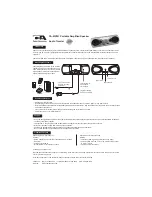
The System Scan feature monitors the programmed systems in sequence. When a message is detected that your
transceiver is programmed to receive, scanning stops and the message is received. Shortly after the message is
complete, scanning resumes.
System scanning is turned on and off by the front panel SCN key. When scanning is enabled, “SCN” is indicated in
the lower part of the display.
When scanning is actually occurring, the group number is replaced by a dash and “IN SCAN” is displayed instead
of a unique system or group identification. The dash also indicates that group scanning is occurring (see page 40). Since
the system number continues to be displayed, you can see which system is currently selected, especially when auto-
registration is used. Scanning is sequential through the programmed systems unless they are locked out as described in
“Scan List Programming” which follows. The display always changes to the system of a call and usually changes to the
group of a call.
The selected system or group can be changed while scanning by simply pressing the S or G keys or turning the
quick select switch. This temporarily halts scanning and changes the selected system or group. To display the selected
system and group while scanning, halt scanning by pressing the SCN key or Auxiliary switch. Some transceivers may
be programmed so that the conventional and some Multi-Net systems are not scanned. If this is the case with your trans-
ceiver, your system operator will tell you which are not scanned.
Scan Resume Delay
After a message is received or transmitted in the scan mode, there is a programmable delay period of 1-8 seconds
before scanning resumes. When a message is received, this delay prevents another message from being received before
a response can be made (see next section). When a message is transmitted, this delay ensures that a response to your
message is heard instead of some other message occurring on another system or group.
Transmitting In Scan Mode
When you transmit while scanning (indicated by a dash in the group display), the transmission always occurs on the
currently selected system and group. If a message is received while scanning, scanning stops and the system and
group of the call are displayed. If the PTT switch is pressed to respond to this call, the system/group on which the
transmission occurs is controlled by the transmit revert configuration that has been programmed by your system op-
erator. The following configurations are available:
Temporary -
As long as you respond before the scan delay expires (see preceding section), the response occurs on
the system/group of the call. If you respond after scanning resumes, the transmission occurs on the selected system/
group which may not be the same as that of the call. For example, if System 1/Group 2 was displayed when scanning
was turned on and a call is received on System 3/Group 4, System 3/Group 4 is displayed and the call is received.
If a response is then made, the transmission occurs on System 3/Group 4. However, if it is not made until after scan-
ning resumes, it occurs on System 1/Group 2.
Last Selected
- Transmissions always occur on the selected system/group, even when responding to a call. There-
fore, if this configuration was programmed for the preceding example, the transmission would occur on System 1/
Group 2, not System 3/Group 4. To respond to that call, you would first have to manually change the selected system
and group using the S or G keys or the quick select switch. You can also make the system and group of a call the
selected system/group by turning off scanning before scanning resumes.
Last Received -
The selected system/group changes to the system/group of the call. Therefore, you can always re-
spond without having to manually change the system/group.













































